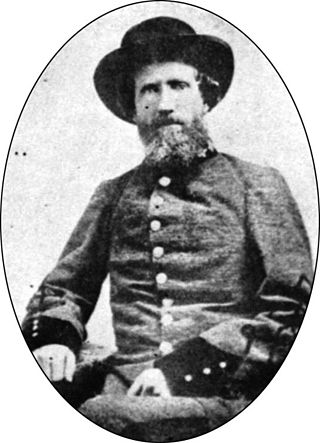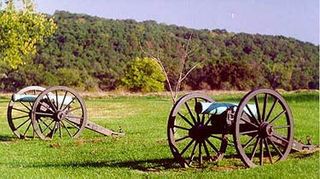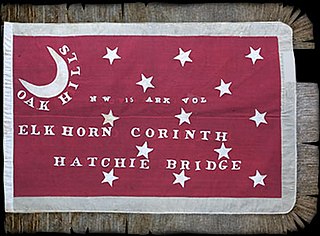Related Research Articles

Evander McNair was a brigadier general in the Confederate States Army during the American Civil War.

The Battle of Wilson's Creek, also known as the Battle of Oak Hills, was the first major battle of the Trans-Mississippi Theater of the American Civil War. It was fought on August 10, 1861, near Springfield, Missouri. Missouri was officially a neutral state, but its governor, Claiborne Fox Jackson, supported the South and secretly collaborated with Confederate troops.
The following is a list of engagements that took place in 1861 during the American Civil War.
The Battle of Dry Wood Creek, also known as the Battle of the Mules, was fought on September 2, 1861, in Vernon County, Missouri, during the American Civil War. After his victory at the Battle of Wilson's Creek on August 10, Sterling Price and the Missouri State Guard moved further north into Missouri. A force of Union troops under James H. Lane moved from Fort Scott, Kansas to attempt an interception of Price's army, and set an ambush along Dry Wood Creek. Price's Missouri State Guard troops outnumbered Lane's Kansas troops, and after a two hour skirmish forced Lane to retreat to Fort Scott. In their retreat, Lane's troops abandoned their supplies and mules to the Missourians. Price followed up his victory by continuing his northward march, culminating in another victory at the siege of Lexington, September 13 to 20, before returning south shortly afterwards.
The Battle of Roan's Tan Yard, also known as the Battle of Silver Creek, was a minor battle fought during the American Civil War on January 8, 1862, in Randolph County, Missouri. After back-and-forth operations throughout 1861, the pro-Confederate Missouri State Guard under the command of Sterling Price had been confined to southwestern Missouri. In December 1861, Price authorized recruiting and raiding activities in the central portion of the state, with the North Missouri Railroad being a major target. In January 1862, Major W. M. G. Torrence of the Union Army located a Missouri State Guard base in Randolph County and attacked it on January 8 with elements of four cavalry regiments. The camp, which was commanded by Colonel John A. Poindexter, put up little resistance and was soon overrun. Large quantities of supplies were captured in the abandoned camp, which was destroyed. The action at Roan's Tan Yard, along with a Missouri State Guard defeat at the Battle of Mount Zion Church the preceding December, led to a decrease in pro-Confederate activity in central Missouri.

Wilson's Creek National Battlefield, located near Republic, Missouri, preserves the site of the Battle of Wilson's Creek. Fought on August 10, 1861, the battle was the first major American Civil War engagement west of the Mississippi River. In the battle, a Confederate army commanded by Benjamin McCulloch and Sterling Price defeated a smaller Union army commanded by Nathaniel Lyon. However, the Confederates were unable to hold much of Missouri, and a Confederate defeat at the Battle of Pea Ridge effectively solidified Union control of the state. Major features include a five-mile automobile tour loop, the restored 1852 Ray House, and "Bloody Hill", the site of the final stage of the battle. The site is located near Republic in southwestern Missouri just southwest of the city of Springfield. It has been a unit of the National Park Service since 1960, and was listed on the National Register of Historic Places in 1966.

The Army of the West, also known as the Trans-Mississippi District, was a formation of the Confederate States Army during the American Civil War that was a part of the Army of Mississippi. It saw action in the Battle of Pea Ridge, Battle of Corinth, and Battle of Iuka and consisted of about 20,000 personnel.
The following Union Army units and commanders fought in the Battle of Wilson's Creek of the American Civil War, fought on August 10, 1861, near Springfield, Missouri. The Confederate order of battle is shown separately.

James S. Rains was a senior officer of the Missouri State Guard (MSG) who fought in the Trans-Mississippi Theater of the American Civil War. Born in Tennessee, Rains moved to Missouri by 1840, and was a farmer, politician, judge, and militia officer. He also served as an Indian agent from 1845 to 1849, and participated in the California Gold Rush. He was appointed to command of the 8th Division of the MSG in May 1861, and may have commanded all MSG forces at the Battle of Carthage later that year. In August, his men were routed at the Battle of Dug Springs, an incident which became known as "Rains's Scare".

Nicholas Bartlett Pearce was a brigadier general in the Arkansas State Troops during the American Civil War. He led a brigade of infantry in one of the war's earliest battles in the Trans-Mississippi Theater before serving as a commissary officer in the Confederate States Army for the rest of the war.

William Yarnel Slack was an American lawyer, politician and military officer. Born in Kentucky, Slack moved to Missouri as a child and later entered the legal profession. After serving in the Missouri General Assembly from 1842 to 1843, he served as a captain in the United States Army during the Mexican-American War. He saw action at the Battle of Embudo Pass and the Siege of Pueblo de Taos. Returning to a legal career, Slack became influential in his local area.
The 2nd Kansas Infantry Regiment was an infantry regiment that served in the Union Army during the American Civil War. Recruited in May 1861, it formally organized on June 20. Sent into Missouri, it participated in several small actions in the Springfield area before fighting in the Battle of Wilson's Creek on August 10, where it suffered 70 casualties out of about 600 men present excluded a detached cavalry company. Ordered back to Kansas after the battle, it fought in several small actions in Missouri and later mobilized in Kansas after enemy forces captured Lexington, Missouri, as Kansas was believed to be threatened by the Lexington movement. The unit was disbanded on October 31, with some of its men, including its commander, joining the 2nd Kansas Cavalry Regiment. Colonel Robert B. Mitchell commanded the regiment until he was wounded at Wilson's Creek and Lieutenant Colonel Charles W. Blair took command.

The 3rd Infantry, Arkansas State Troops (1861) was an Arkansas State infantry regiment that served during the American Civil War. The regiment was designated as the 2nd Infantry, Arkansas State Troops, by the State Military Board, but it was named the 3rd Arkansas by Brigadier General Nicholas Bartlett Pearce, Commander, 1st Division, Provisional Army of Arkansas. The regiment is generally referred to as the "3rd Regiment, Arkansas State Troops", or "Gratiot's Regiment" in contemporary accounts. This unit is distinguished from the 3rd Arkansas Infantry Regiment which served in the Eastern Theater of War in the Confederate Army of Northern Virginia. The unit is also distinguished from a later state organization known as Adams' 3rd Arkansas State Troops, which was organized in 1862 and participated in the Battle of Prairie Grove before being disbanded.

The 4th Infantry, Arkansas State Troops (1861) was an Arkansas State infantry regiment that served during the American Civil War. After being raised in mid-1861, the regiment was assigned to the command of Brigadier General Nicholas Bartlett Pearce, who was the commander of the 1st Division, Provisional Army of Arkansas. The regiment is referred to as the "4th Regiment Arkansas Volunteers", or "Walker's Regiment" in contemporary accounts; it was disbanded shortly after the Battle of Wilson's Creek in August 1861. Another Arkansas unit also had the designation 4th Arkansas, the 4th Arkansas Infantry Regiment which formed after the Battle of Wilson's Creek, and spent most of its service in the Confederate Army of Tennessee. There is no connection between the two units.
The 5th Regiment, Arkansas State Troops (1861) was an Arkansas State infantry regiment that served during the American Civil War. Formed in mid-1861, the regiment was assigned to the command of Brigadier General Nicholas Bartlett Pearce, commander, 1st Division, Provisional Army of Arkansas. It was disbanded after the Battle of Wilson's Creek in August 1861. Another Arkansas unit also had the designation 5th Arkansas, the 5th Arkansas Infantry Regiment which belonged to the Confederate Army of Tennessee. There is no connection between the two units.
The 1st Cavalry Regiment, Arkansas State Troops (1861) was an Arkansas cavalry regiment during the American Civil War. The regiment was organized at Camp Walker, near Harmony Springs, Benton County, Arkansas. The regiment was officially designated as the Third Regiment (Cavalry), Arkansas State Troops by the State Military Board, but was designated as the 1st Arkansas Cavalry by Brigadier General Nicholas Bartlett Pearce, Commander, 1st Division, Provisional Army of Arkansas. The regiment is referred to as the "Carroll's Regiment" in contemporary accounts.

The 15th (Northwest) Arkansas Infantry Regiment (1861–1865) was a Confederate Army infantry regiment during the American Civil War. The unit was originally formed as the 3rd Arkansas Infantry Battalion. After receiving the required 10 companies, the unit was redesignated as the 21st (McRae's) Arkansas Infantry Regiment. Upon recognition that there was already a 21st Arkansas, the unit was again redesignated as the 15th Arkansas Infantry Regiment. This was the third Arkansas unit to bear the designation "15th Arkansas". The others are the 15th (Josey's) Arkansas Infantry Regiment and the 15th (Gee/Johnson) Arkansas Infantry Regiment. The unit saw action both west and east of the Mississippi, before serving in the Vicksburg campaign. The regiment was surrendered at Vicksburg in July 1863. After being paroled and exchanged, the regiment was consolidated with other depleted Arkansas regiments to form the 1st (Trans-Mississippi) Arkansas Consolidated Infantry Regiment.
The 1st Arkansas Light Artillery, originally known as the Fort Smith Artillery (1861), was an artillery battery of the Confederate States Army that served during the American Civil War. The unit was actually a pre-war volunteer militia company which was activated as part of the Arkansas State Troops and mustered out of state service following the Battle of Wilson's Creek. The unit immediately re-organized and re-enlisted for Confederate service. The unit spent the majority of the war in the western theater, fighting as part of the Confederate Army of Tennessee. The unit is also known as Reid's Battery, Provence's Battery, Humphreys' Battery and finally Rivers' Battery.
The Battle of Van Buren was fought at Van Buren, Arkansas, on December 28, 1862, during the American Civil War. After defeating Confederate forces led by Major General Thomas C. Hindman at the Battle of Prairie Grove on December 7, 1862, Union forces under Brigadier Generals James G. Blunt and Francis J. Herron prepared for a raid against the Confederate positions at Van Buren and Fort Smith. Disease, lack of supplies, and desertion had previously forced Hindman to begin withdrawing most of his force from the area. Setting out on December 27, the Union troops struck an outlying Confederate cavalry unit near Drippings Spring, north of Van Buren, on the morning of December 28. The Confederate cavalry fled to Van Buren, which was then overrun by Union troops.
Hiram Bledsoe's Missouri Battery was an artillery battery that served in the Missouri State Guard and the Confederate States Army during the American Civil War. The battery was formed when the Missouri State Guard was formed as a pro-secession state militia unit in response to the Camp Jackson affair. As part of the Missouri State Guard, the unit was engaged in the Engagement near Carthage and the Battle of Wilson's Creek during mid-1861, before fighting at the Battle of Dry Wood Creek and the Siege of Lexington later that year when Major General Sterling Price led the Guard northwards towards the Missouri River. After the Missouri State Guard retreated into Arkansas in early 1862, Bledsoe's Battery served during the Confederate defeat at the Battle of Pea Ridge in March. The battery, as part of the Army of the West, transferred across the Mississippi River into Tennessee in April, where it left the Guard to enter Confederate service on April 21.
References
- NPS Order of Battle
- Brooksher, William Riley. Bloody Hill: The Civil War Battle of Wilson’s Creek (Washington: Brassey's, Inc.), 2000. ISBN 1-57488-205-8
- Piston, William Garrett & Richard W. Hatcher, III. Wilson's Creek: The Second Battle of the Civil War and the Men Who Fought It (Chapel Hill, NC: The University of North Carolina Press), 2003. ISBN 0-8078-5575-8